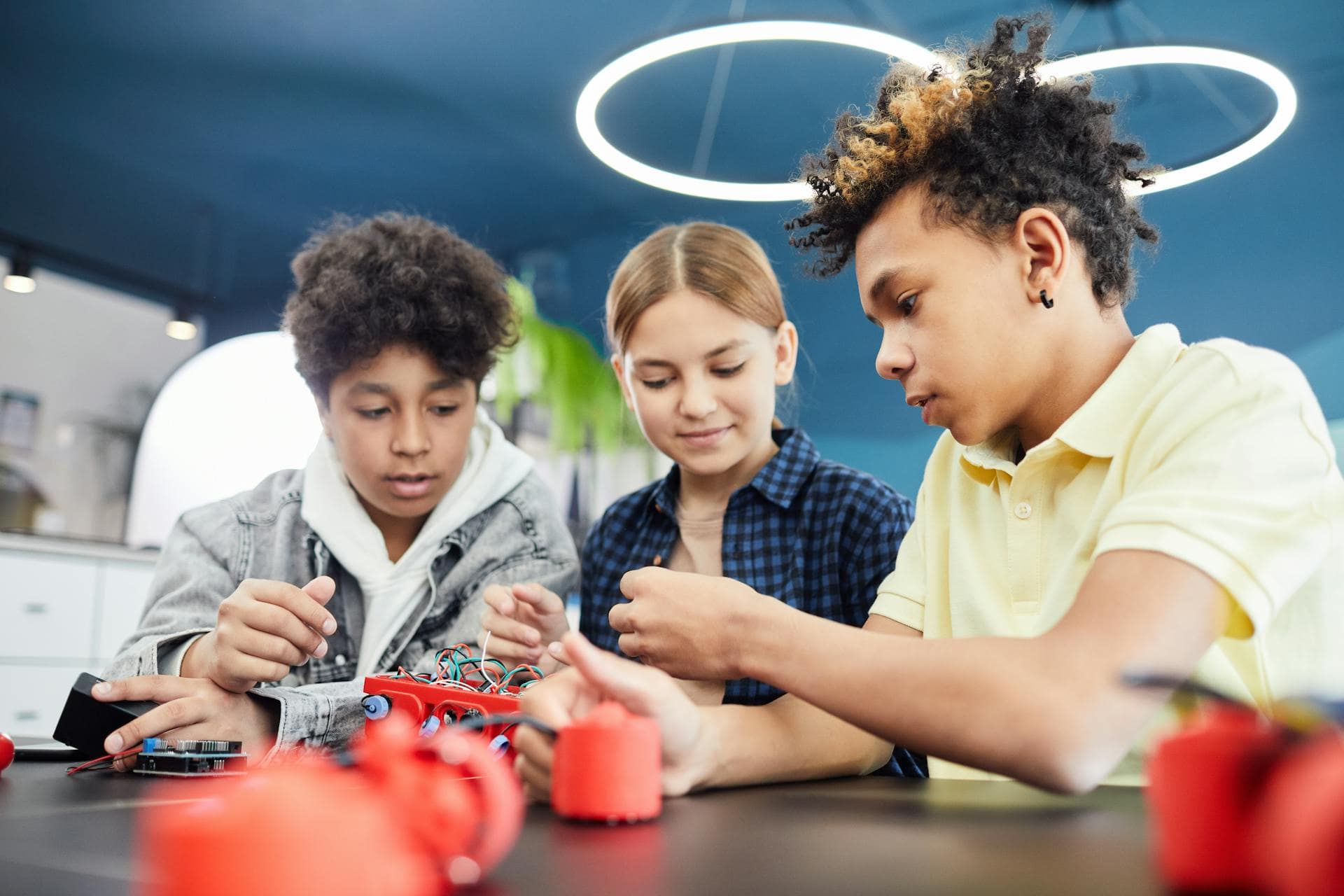
“If you want them to HEAR it, you talk. If you want them to LEARN it, THEY TALK.”
Imagine you are sitting in a classroom filled with enthusiastic 5-year-olds. The teacher just started her lesson about a marble track. As you see the excitement of the little ones trying to predict which way the marble will go, you notice that their curiosity and enjoyment is mainly expressed by doing, i.e. trying different tubes and changing parts of the marble track. Developing new skills and building new knowledge starts with exploring: children need interesting material that triggers their curiosity and facilitates learning. The teacher in this example did a very good job by choosing the marble track as a subject for her lesson since it clearly triggers the interest of the children.
Hands-on-minds-on experience
When you look more closely though, you will notice how little language is used while experimenting with the marble track. The teacher occasionally asks a question like “Where do you think it will come out?” or utters “Look, there it is!”. Moreover, these simple (deictic) verbalizations are accompanied by a lot of pointing. In this context, these sentences are easily understood and the children immediately respond to them by doing. However, the language that is used in the classroom situation just presented is not very rich in terms of vocabulary and sentence constructions. In the classroom, language is the medium of learning and instruction, which makes a rich language environment so important. The 5-year-olds in the example need rich input and encouragement in order to expand their vocabulary and develop more complex sentence constructions because, although they have a spontaneous interest in things like marble tracks, they are not always successful in describing, for instance, the functioning of a marble track. They find it hard to verbalize causal relations and abstract phenomena because they lack the required complex language skills.
A good starting point to improve these more complex language skills of children is to tap into the children’s spontaneous interest like the teacher in the example does with introducing the marble track. This context provides great opportunities for so called hands-on-minds-on experience, which basically means that children can both experiment with the material themselves and are encouraged to reason about the underlying principles of the experiments, which helps them to form scientific concepts. In order to learn how to verbalize argumentations about scientific concepts, children need to acquire more complex language skills. This complex form of language use, which is referred to as academic language, includes vocabulary, grammatical structures and strategies to construct more sophisticated and precise ways of using language.
Teachers, language and 5-year-olds
Academic language is mostly used in papers, scientific articles and so on. The 5-year-olds in Kindergarten obviously do not need to learn how to write a scientific article right away, but the teacher should make a start with providing the children with rich language input. It is at this young age that children are sponges; they absorb new information at a very rapid pace and language learning occurs based on input and practice. Therefore, the teacher should introduce children to this so-called academic language by using complete and more complex sentences, and implicitly and explicitly teaching new vocabulary. Returning to the lesson about the marble track, the teacher could say, for example: “The steepness of the marble track causes the blue marble to roll down so fast.” This is a form of linguistic scaffolding called modelling in which the teacher provides rich input to set an example.
Besides modelling and explicitly teaching new vocabulary, there is an even more important contribution the teacher can make: he or she can actively encourage children to verbalize their thoughts. The teacher is a very important factor, as Spencer Kagan said: “If you want them to HEAR it, you talk. If you want them to LEARN it, THEY TALK.” Children need to be encouraged to verbalize their thoughts about scientific concepts, for instance by a teacher who asks open thought-provoking questions that encourage children’s’ reasoning skills, as opposed to the more traditional way of teaching in which the teacher tells how it works and the children sit down and listen. The teacher can ask questions like: “What would happen if we would change the red tube on the marble track?” or “Why do you think the marble will come out of this blue tube?” These questions require higher cognitive processes like scientific reasoning. Children who are encouraged to verbalize their thoughts about scientific phenomena learn to reason because talking helps children to clarify their thinking.
The teacher is a very important factor, as Spencer Kagan said: “If you want them to HEAR it, you talk. If you want them to LEARN it, THEY TALK.”
It is beyond the scope of this blog to go into detail about the relation between language and cognition but, regardless of what the exact relation is, higher cognitive processes like scientific reasoning require a sophisticated form of language. Children need to learn how to describe causal relations with sentence constructions like “The marble rolls down fast because the ramp is very steep”. The teachers should help children learn how to use language effectively as a tool for thinking. They need to be aware of the importance of these more complex language skills because a lack of refined language skills can become an obstacle in learning in the domain of science and technology. Therefore, eliciting academic language in children should be an important explicit goal for teachers in science and technology education.
Now, the next time when you interact with a young child, take a moment to listen to what you actually are saying to the child. Do you use a lot of content words and complete sentences or is it more like “Look at this! Now I do this one in here. Can you do that?”…?
Relevant links and publications
NOTE: Image by rachel_pics, licenced under CC BY 2.0




Thank you, Astrid, for a very thoughtful and insightful post! And, thank you for quoting Spencer Kagan, one of the most inspiring promulgators of cooperative learning. If we want students to develop academic language, we need to structure opportunities for them to interact with text through comprehensible input then participate in face-to-face interactions with peers that lead to academic discourse.
Greetings from California!